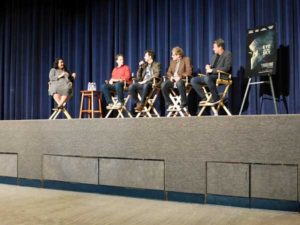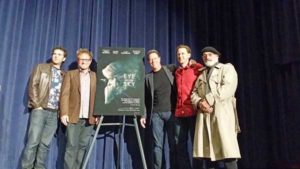
Below The Line recently participated in two screenings for Eye in the Sky, a different kind of war film, that director Gavin Hood said was a film that he wanted to make “that would keep you on the edge of your seat but leave you with something to talk about.” That something to talk about is the moral questions that arise when war is conducted with robotics and computers controlling drones that drop death from the sky with pinpoint precision, but not always without collateral damage.
Eye in the Sky, starring Helen Mirren, Aaron Paul, Alan Rickman, Barkhad Abdi, Jeremy Northam, Iain Glen and Phoebe Fox, is the story of a top-secret joint military operation between the U.S. and the U.K. to capture several high-level terrorist targets in Kenya. While monitoring the situation, with the use of some quite fascinating technology, they realize that the terrorists are planning a suicide bomb mission and the “capture” operation triggers the “Kill Chain”, which is the military and political chain of command through which a decision to target an individual goes through before the order to kill that person is given. To complicate an already complicated situation, just as the American pilot (played by Paul) is about to pull the trigger, a young girl enters the “kill zone” to sell bread in the marketplace and more layers of moral dilemma are added.
Filmed on a tight budget of 14 million dollars with a 2-million-dollar rebate, the film was shot completely in Cape Town basically in 5 “pods” that were built by production designer Johnny Breedt and set decorator Fred Du Preez and their crew. The pods allowed for total shooting control for Mirren’s home, her military bunker, the COBRA room in London, Paul’s Ground Control Station in Nevada and the exterior market and target house in Kenya.
Cinematographer Haris Zambarloukos, shot the film in widescreen anamorphic with Michael Bay‘s Black Sails lurking in the background. A helicopter was used for some moving drone shots but wasn’t effective for over 1,500 feet. For those shots, Hood said that they brought in a 280-foot crane and mounted 2 cameras at the top. This worked if they kept the perspective straight down. Hood also said that there were 480 visual effects shots in the film that were the biggest challenges. Visual effects were the bailiwick of Simon Hansen and Nikos Kalaitzidis.
 In order to maintain authenticity, a military advisor was on set at all times. The Reaper drone and Hellfire missiles were absolutely real. The nifty “Micro Aerial Vehicles” (MAVs) were modified to avoid accusations of stealing actual designs from companies currently developing them. The little “bird” that flew around to gain viewpoint access from windows has already been developed by an LA-based defense contractor and the tiny flying beetle, (which was named Ringo in the film) is in development.
In order to maintain authenticity, a military advisor was on set at all times. The Reaper drone and Hellfire missiles were absolutely real. The nifty “Micro Aerial Vehicles” (MAVs) were modified to avoid accusations of stealing actual designs from companies currently developing them. The little “bird” that flew around to gain viewpoint access from windows has already been developed by an LA-based defense contractor and the tiny flying beetle, (which was named Ringo in the film) is in development.
The MAV’s are both fascinating and terrifying. They are enormously useful to be sent into areas where humans can’t safely go, but also have the potential to be equipped with facial recognition and sent on targeted assassinations.
In an interesting quirk, the problem for these MAV’s is not making camera’s small enough for them, but instead long-lasting batteries for them. After hearing a defense contractor talk about this Hood explained that it was made an actual part of the storyline of the film.
With both the sound and film editing the challenge was to find ways meld the film together. Because none of the actors were available to film at the same time, most of the acting was done in segments with green screens as stand-ins for other sets and actors. Hood said, “This resulted in really fragmented pieces of film,” that needed to be woven into a whole while still maintaining the energy, pace and suspense.
In a discussion between Mark Kilian, co-composer, Craig Mann, re-recording mixer and co-supervising sound editor and William R. Dean, sound design and co-supervising sound editor, Dean said that “Gavin wanted to get everyone together in a room prior to filming… we all had a great big table discussion, talked about what the moves means. An idea session.”
Kilian spoke about the “need to make a tapestry of sound that would build bridges, connective tissue.” And in describing the technique they used when improvising with mechanical sounds, “You go into the wave of the sound, and it starts becoming something else.”
All agreed that they did not want to sound to be heavy-handed, as though signaling the entrance of the villain on screen, but they did use sound and the lack of it to punctuate and heighten moments of emotion and tension, as the silence used during the second airstrike. “We played the second strike from the point of view of the pilot,” said Hood.
As for the challenge of making the sounds for the drones, Dean said that he reached out to one of the makers of the drones about coming to record the sound of it. He was told, “That’s classified. I can come around and you can play some sounds for me, and I’ll tell you if it’s right.” So that’s what they did.
“A film is a visual and sound experience. It’s a whole piece and it needs change and rhythm. Because people were in separate parts of the world, I literally shot this movie four times. It was tricky, but it was a wonderful jigsaw puzzle to solve,” said Hood.





